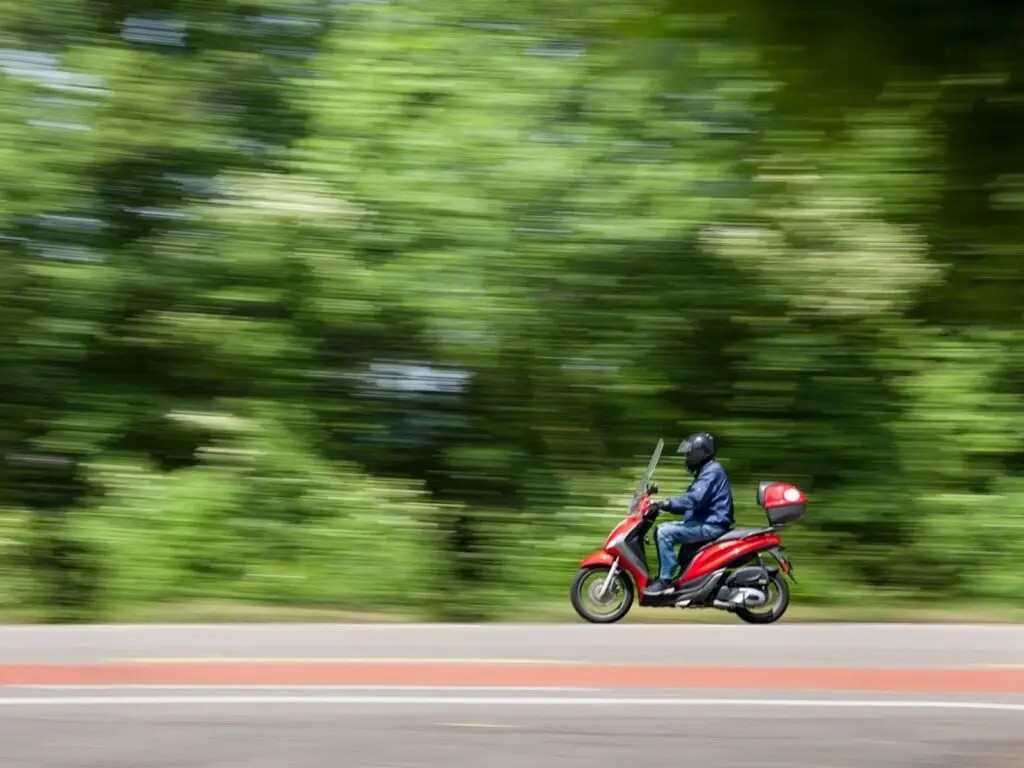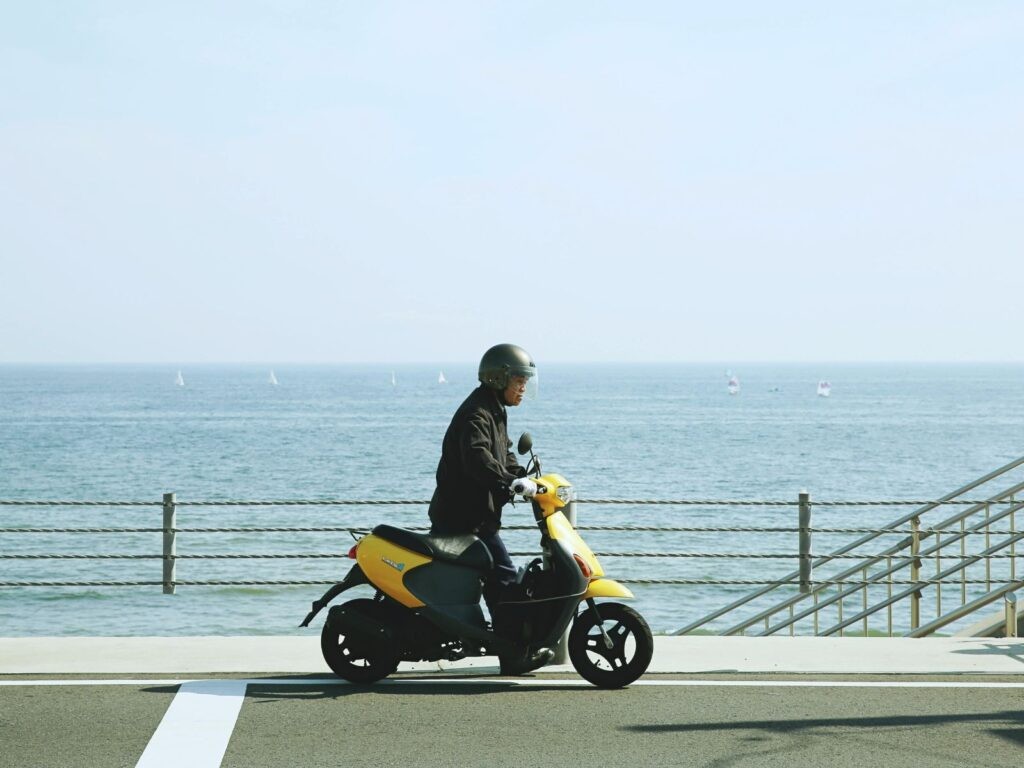What Is A Moped and why should you care? At WHAT.EDU.VN, we break down the key characteristics, legal requirements, and advantages of mopeds, so you can make an informed decision about your transportation options. Discover how a moped could be the perfect solution for your urban commuting needs, and explore related terms like “scooter,” “motorcycle,” and “urban mobility.”
1. Understanding the Basics: What is a Moped?
A moped is a low-speed, two-wheeled vehicle designed for short-distance transportation. Originally, the term “moped” was a blend of “motor” and “pedal,” reflecting the early designs that featured both an engine and pedals. While modern mopeds often lack pedals, they retain their classification based on engine size and speed limitations. These nimble vehicles are often a budget-friendly and convenient choice for navigating city streets.
1.1 Key Characteristics of a Moped
Mopeds possess distinct features that set them apart from scooters and motorcycles. Understanding these characteristics is crucial for anyone considering a moped as their primary mode of transport.
- Engine Size: Typically, mopeds have an engine size of 50cc or less.
- Speed Limit: Mopeds are legally restricted to a maximum speed, often around 30 mph (48 km/h), depending on local regulations.
- Design: Mopeds often feature a step-through frame design, making them easy to mount and dismount.
- Transmission: Many mopeds have automatic transmissions, simplifying the riding experience.
1.2 Moped vs. Scooter: What’s the Difference?
The terms “moped” and “scooter” are often used interchangeably, but there are key distinctions. While both are two-wheeled motor vehicles, their classifications and capabilities differ.
| Feature | Moped | Scooter |
|---|---|---|
| Engine Size | Typically 50cc or less | Can range from 50cc to 750cc or more |
| Speed | Generally limited to 30 mph (48 km/h) | Can exceed 30 mph, depending on engine |
| Frame Design | Step-through frame common | Step-through frame common |
| Legal Definition | Often classified separately | May have different licensing requirements |



1.3 The Evolution of the Moped: From Pedals to Pure Motor Power
The original mopeds were designed with pedals, allowing riders to assist the engine or propel the vehicle without motor power. Over time, however, most manufacturers phased out pedals in favor of more powerful and efficient engines. This evolution has led to some confusion, as many modern mopeds no longer resemble their pedal-equipped predecessors.
2. Legal Aspects of Mopeds: Licensing, Registration, and Regulations
Understanding the legal requirements for operating a moped is essential for responsible ridership. Regulations vary by location, so it’s vital to familiarize yourself with local laws before hitting the road.
2.1 Licensing Requirements for Moped Riders
In many jurisdictions, operating a moped requires a specific type of license or permit. The requirements may differ based on age, engine size, and local regulations. For example:
- Learner’s Permit: Some areas allow individuals to operate a moped with a learner’s permit, often requiring supervision from a licensed driver.
- Moped-Specific License: Other regions mandate a specific moped license, which may involve passing a written test and/or a practical riding exam.
- Driver’s License: In some cases, a standard driver’s license may be sufficient to operate a moped, particularly if the engine size is below a certain threshold.
2.2 Registration and Insurance Requirements
Like other motor vehicles, mopeds typically require registration with the local Department of Motor Vehicles (DMV) or equivalent agency. Registration involves providing proof of ownership, paying applicable fees, and obtaining a license plate. Additionally, most jurisdictions mandate moped insurance to cover potential damages or injuries in the event of an accident.
2.3 Speed Limits and Traffic Laws
Moped riders must adhere to all applicable traffic laws, including speed limits, lane usage rules, and parking regulations. Due to their lower speed capabilities, mopeds may be restricted from certain roadways, such as highways or interstates. It’s crucial to understand these restrictions to ensure safe and legal operation.
3. The Moped Riding Experience: Performance, Handling, and Practicality
Riding a moped offers a unique transportation experience. Their compact size, ease of handling, and fuel efficiency make them ideal for urban environments. However, it’s important to consider their limitations in terms of speed and long-distance travel.
3.1 Performance and Handling Characteristics
Mopeds are known for their nimble handling and maneuverability. Their lightweight design and responsive controls make them easy to navigate through congested traffic and tight spaces. However, their limited engine power means they may struggle on steep inclines or when carrying heavy loads.
3.2 Fuel Efficiency and Cost Savings
One of the biggest advantages of mopeds is their exceptional fuel efficiency. Mopeds can achieve impressive gas mileage, often exceeding 100 miles per gallon (mpg), resulting in significant cost savings compared to cars or larger motorcycles. This makes them an attractive option for budget-conscious commuters.
3.3 Practicality in Urban Environments
Mopeds are particularly well-suited for urban environments due to their small size and ease of parking. They can squeeze into tight parking spots that cars can’t access, and their step-through frame design makes them convenient for running errands and making frequent stops.
4. Moped Safety: Essential Gear, Riding Techniques, and Risk Awareness
Safety should always be a top priority for moped riders. While mopeds may seem less intimidating than motorcycles, they still require proper training, protective gear, and a responsible attitude.
4.1 Essential Safety Gear for Moped Riders
- Helmet: A properly fitted helmet is the single most important piece of safety gear. Look for a helmet that meets or exceeds DOT (Department of Transportation) safety standards.
- Eye Protection: Wear a face shield or goggles to protect your eyes from wind, debris, and insects.
- Gloves: Gloves provide protection for your hands in case of a fall and improve grip on the handlebars.
- Jacket and Pants: Wear a jacket and pants made from abrasion-resistant materials to protect your skin from scrapes and cuts.
- Footwear: Wear sturdy shoes or boots that cover your ankles to provide support and protection.
4.2 Defensive Riding Techniques for Mopeds
- Be Visible: Wear bright clothing and use reflective tape to increase your visibility to other drivers.
- Maintain a Safe Following Distance: Allow plenty of space between you and the vehicle in front of you to give yourself time to react to sudden stops.
- Scan Your Surroundings: Constantly scan your surroundings for potential hazards, such as potholes, pedestrians, and other vehicles.
- Use Signals: Use your turn signals well in advance of making a turn or changing lanes.
- Avoid Distractions: Avoid using your phone or engaging in other distracting activities while riding.
4.3 Awareness of Moped-Specific Risks
- Limited Speed: Be aware that your moped’s limited speed can make it difficult to keep up with traffic on certain roads.
- Small Size: Other drivers may have difficulty seeing you due to your moped’s small size.
- Road Hazards: Be extra cautious of road hazards, such as potholes, gravel, and uneven surfaces, as they can be more dangerous for mopeds than for larger vehicles.
5. Moped Maintenance: Keeping Your Ride in Top Condition
Regular maintenance is essential for ensuring the longevity and reliability of your moped. Simple tasks like checking tire pressure, changing the oil, and inspecting the brakes can prevent costly repairs and keep you safe on the road.
5.1 Basic Moped Maintenance Tasks
- Check Tire Pressure: Check your tire pressure regularly and inflate to the recommended level.
- Change Oil: Change your oil according to the manufacturer’s recommendations.
- Inspect Brakes: Inspect your brakes regularly and replace worn brake pads or shoes.
- Check Lights: Make sure all your lights are working properly.
- Clean Air Filter: Clean or replace your air filter regularly to ensure optimal engine performance.
5.2 Troubleshooting Common Moped Problems
- Engine Won’t Start: Check the fuel level, spark plug, and battery.
- Poor Performance: Check the air filter, fuel filter, and spark plug.
- Brakes Not Working: Check the brake pads or shoes, brake lines, and brake fluid level.
- Flat Tire: Repair or replace the flat tire.
5.3 When to Seek Professional Moped Repair
While many moped maintenance tasks can be performed at home, some repairs require the expertise of a professional mechanic. If you’re not comfortable working on your moped or if you encounter a problem you can’t diagnose, it’s best to seek professional help.
6. Mopeds and the Environment: Sustainability and Eco-Friendliness
Mopeds offer a more sustainable and eco-friendly transportation option compared to cars. Their smaller engines consume less fuel and produce fewer emissions, reducing your carbon footprint and contributing to a cleaner environment.
6.1 Reduced Emissions Compared to Cars
Mopeds produce significantly fewer emissions than cars, especially older models. Their smaller engines and lighter weight result in lower greenhouse gas emissions and reduced air pollution.
6.2 Fuel Efficiency and Conservation
Mopeds’ exceptional fuel efficiency helps conserve natural resources and reduces reliance on fossil fuels. By choosing a moped over a car, you can significantly reduce your fuel consumption and save money at the pump.
6.3 Mopeds and Urban Congestion
Mopeds can help alleviate urban congestion by taking up less space on the road and in parking areas. Their small size allows them to navigate through traffic more easily, reducing travel times and improving overall traffic flow.
7. Buying a Moped: New vs. Used, Brands, and Price Range
When buying a moped, you have the option of purchasing a new or used model. Each option has its advantages and disadvantages, and the best choice depends on your budget, needs, and preferences.
7.1 Advantages and Disadvantages of Buying New
Advantages:
- Warranty: New mopeds typically come with a manufacturer’s warranty, providing coverage for potential repairs.
- Latest Technology: New models often feature the latest technology and safety features.
- Clean Slate: You know the moped’s history and that it hasn’t been abused or neglected.
Disadvantages:
- Higher Price: New mopeds are more expensive than used models.
- Depreciation: New vehicles depreciate in value quickly.
7.2 Advantages and Disadvantages of Buying Used
Advantages:
- Lower Price: Used mopeds are significantly cheaper than new models.
- Slower Depreciation: Used vehicles depreciate more slowly than new ones.
Disadvantages:
- No Warranty: Used mopeds typically don’t come with a warranty.
- Unknown History: You may not know the moped’s history or how well it has been maintained.
- Potential Repairs: Used mopeds may require repairs sooner than new models.
7.3 Popular Moped Brands and Models
- Honda: Honda is a well-known and respected manufacturer of mopeds and motorcycles.
- Yamaha: Yamaha is another popular brand known for its quality and reliability.
- Piaggio: Piaggio is an Italian manufacturer known for its stylish and innovative mopeds.
- Vespa: Vespa is an iconic Italian brand that produces stylish and high-quality scooters, some of which qualify as mopeds.
- Genuine: Genuine Scooters is a brand that specializes in affordable and reliable scooters and mopeds.
7.4 Moped Price Range: What to Expect
The price of a moped can vary depending on the brand, model, features, and condition. New mopeds typically range from $2,000 to $5,000, while used mopeds can be found for as little as $500 to $2,000.
8. Moped Customization: Personalizing Your Ride
Many moped owners enjoy customizing their rides to reflect their personal style and improve performance. Customization options range from simple cosmetic upgrades to more complex mechanical modifications.
8.1 Cosmetic Upgrades for Mopeds
- Paint: A custom paint job can give your moped a unique and personalized look.
- Decals: Decals and stickers can add visual interest and personality to your ride.
- Seats: A custom seat can improve comfort and style.
- Mirrors: Aftermarket mirrors can enhance visibility and add a touch of style.
- Lights: LED lights can improve visibility and give your moped a modern look.
8.2 Performance Enhancements for Mopeds
- Exhaust: An aftermarket exhaust system can improve engine performance and sound.
- Carburetor: Upgrading the carburetor can increase fuel flow and improve throttle response.
- Air Filter: A high-performance air filter can improve airflow and engine performance.
- Transmission: Upgrading the transmission can improve acceleration and top speed.
8.3 Legal Considerations for Moped Modifications
Before making any modifications to your moped, it’s important to check local laws and regulations. Some modifications may be illegal or may require inspection and approval from a certified mechanic.
9. The Future of Mopeds: Electric Models and Emerging Technologies
The moped industry is evolving rapidly, with electric models and other emerging technologies poised to transform the way we think about urban transportation. Electric mopeds offer a cleaner, quieter, and more efficient alternative to traditional gasoline-powered models.
9.1 The Rise of Electric Mopeds
Electric mopeds are gaining popularity due to their environmental benefits, low operating costs, and ease of use. They offer instant torque, smooth acceleration, and zero emissions, making them ideal for urban commuting.
9.2 Benefits of Electric Mopeds
- Zero Emissions: Electric mopeds produce no emissions, contributing to cleaner air and a healthier environment.
- Low Operating Costs: Electric mopeds are cheaper to operate than gasoline-powered models due to lower fuel and maintenance costs.
- Quiet Operation: Electric mopeds are much quieter than gasoline-powered models, reducing noise pollution.
- Convenient Charging: Electric mopeds can be charged at home or at public charging stations.
9.3 Emerging Technologies in the Moped Industry
- Smart Mopeds: Some mopeds are now equipped with smart features, such as GPS tracking, smartphone connectivity, and anti-theft systems.
- Autonomous Mopeds: While still in the early stages of development, autonomous mopeds could revolutionize urban transportation by providing safe and efficient mobility for all.
- Alternative Fuels: Some manufacturers are exploring alternative fuels, such as biofuels and hydrogen, to power mopeds.
10. Moped Communities and Resources: Connecting with Fellow Riders
Connecting with other moped enthusiasts can enhance your riding experience and provide valuable resources for maintenance, customization, and advocacy.
10.1 Online Moped Forums and Communities
Numerous online forums and communities cater to moped enthusiasts. These platforms provide a space to share information, ask questions, and connect with fellow riders from around the world.
10.2 Local Moped Clubs and Events
Joining a local moped club can provide opportunities to meet other riders, participate in group rides, and attend moped-related events.
10.3 Moped Advocacy Groups
Moped advocacy groups work to promote the interests of moped riders and advocate for policies that support safe and responsible moped use.
Do you have any questions about mopeds that weren’t answered here? Don’t hesitate to ask! At WHAT.EDU.VN, we provide a free and easy platform to get your questions answered quickly by knowledgeable community members. Visit WHAT.EDU.VN today at 888 Question City Plaza, Seattle, WA 98101, United States, or reach out via WhatsApp at +1 (206) 555-7890. We’re here to help you navigate the world of mopeds and beyond.
FAQ: Common Questions About Mopeds
| Question | Answer |
|---|---|
| What is the legal definition of a moped? | According to the National Highway Traffic Safety Administration (NHTSA), a moped is a two- or three-wheeled vehicle with an engine size of 50cc or less and a maximum speed of 30 mph. [Source: NHTSA] |
| Do I need a license to operate a moped? | Licensing requirements vary by state. Some states require a moped-specific license, while others allow operation with a standard driver’s license. Check your local DMV for specific regulations. |
| Are mopeds allowed on highways? | Generally, mopeds are not allowed on highways due to their low speed. Check your local traffic laws for specific restrictions. |
| What is the average fuel efficiency of a moped? | Mopeds are known for their excellent fuel economy, often achieving over 100 miles per gallon. |
| Is moped insurance required? | Most states require moped insurance to cover liability in case of an accident. Check your local insurance regulations for specific requirements. |
| What is the difference between a moped and a scooter? | While the terms are often used interchangeably, mopeds typically have smaller engines (50cc or less) and lower top speeds than scooters. Scooters can have larger engines and higher speeds. |
| What safety gear should I wear when riding a moped? | Essential safety gear includes a helmet, eye protection, gloves, a jacket, and sturdy footwear. |
| How often should I maintain my moped? | Regular maintenance is crucial for moped longevity. Check tire pressure, oil level, and brake function regularly. Follow the manufacturer’s recommendations for scheduled maintenance. |
| Are electric mopeds a good option? | Electric mopeds offer environmental benefits, low operating costs, and quiet operation, making them a viable alternative to gasoline-powered mopeds. |
| Where can I find more information about mopeds? | Online forums, local moped clubs, and advocacy groups are excellent resources for moped enthusiasts. Visit what.edu.vn for a free platform to ask questions and get answers from knowledgeable community members. |

